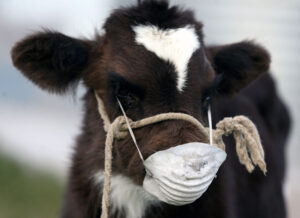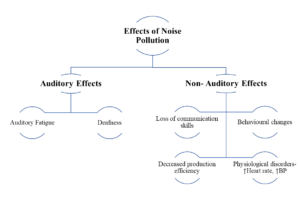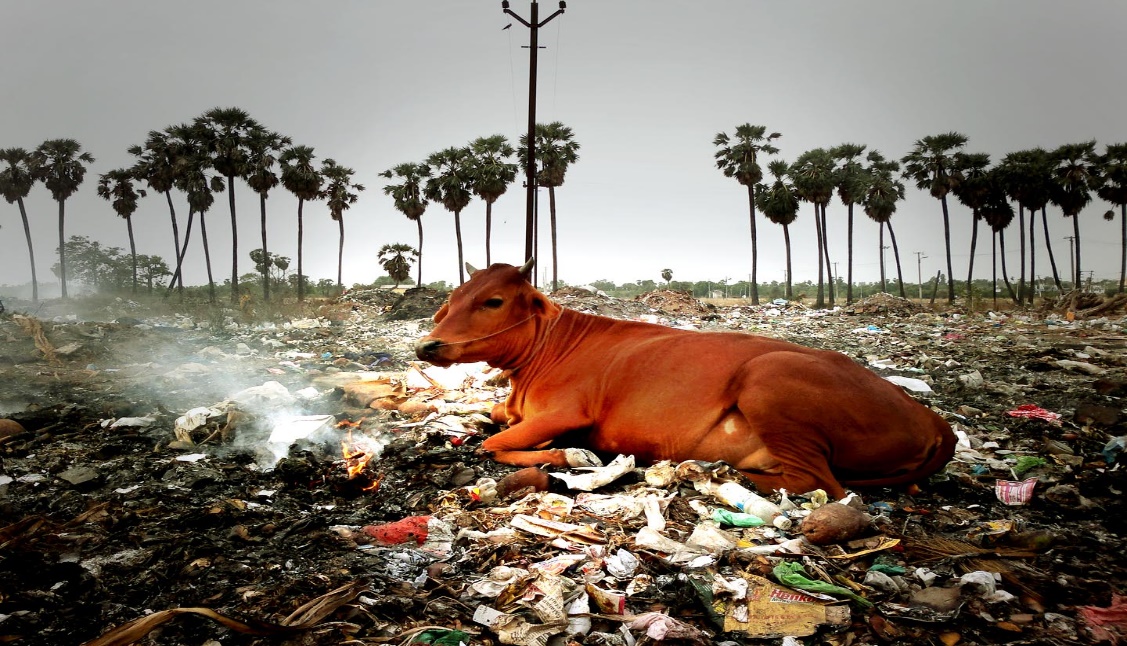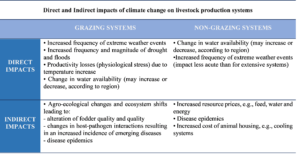The consequences of Pollution on Livestock and Livestock Products
1*Gayatri Gujar, 2Monika, 3Devkishan Gurjar and 4Nistha Yadav
1PhD, Livestock Production Management
2PhD, Veterinary Parasitology
3PhD scholar, Department Livestock Production Management, CVAS-Udaipur
4PhD scholar, Department of Animal Genetics and Breeding, CVAS-Bikaner
*Corresponding author: gujargayatri@gmail.com
INTRODUCTION
- Pollution has become a key adversary of all life forms on earth, from microplastics posing existential threat to marine organisms, to the smoky hue that envelops India’s capital Delhi every year, the consequences of pollution is being felt globally. In today’s world, pollution is a major talking point among the countries, still there is a paucity of work done on its effect on livestock in specific. Livestock being considered only for economic returns, not much is taken into consideration when it comes to pollution. In terms of the ecosystem, it’s important to note that many of these animals are a part of the food chain. If they are inhaling toxins or drinking contaminated water, humans can become exposed by eating their meat and eggs, or drinking their milk. There are many types of pollution – the study of air, water, land, noise and radiation pollution requires special mention in the context of domestic animals.
- EFFECTS OF AIR POLLUTION ON LIVESTOCK
- The effect of pollution on livestock may be:
- – Direct e.g., health hazards, irritation, behavioural changes etc.
- -Indirect e.g., climate change which in turn will affect animals.

- Direct Effects of Air Pollution
- Animals have to battle two kinds of air pollution: – Indoor pollution and Outdoor pollution, Indoor pollution becomes more important in present times with highly intensive rearing systems. Animals in urban areas are at particular risk of smog and exhaust pollutants. Suburban and rural animals can be exposed to the toxins sprayed as insecticides, fungicides and herbicides. The direct effects are particularly manifested in the form of ill health, loss of production efficiency and a decreased life span.
- Pollutants may enter the system by inhalation or ingestion. In air pollution, mostly inhalation triggers the health problems, but occasionally deposition of particles from industrial exhaust on pasture land may affect health directly. Eventually, this may result in toxic residues in meat, milk or eggs without obvious clinical symptoms displayed by the animals producing these products. Inhalation of pollutants may result in respiratory problems like emphysema, anthracosis etc: cardiovascular diseases and even digestive system troubles.
- The effect of indoor air pollution is much more in case of swine & poultry:
- For dairy cattle, goats and sheep these facilities are quite open and air quality is to a certain degree comparable with the outdoor air quality. The quality of this air is still much better than that of the closed facilities for swine and poultry (Koerkamp et al., 1998). The bird’s respiratory tracts are challenged by dust coming off the litter. In layer houses larger accumulation of manure is there, usually in pits, due to longer housing duration which are only emptied infrequently (Harry, 1978). Hence, it is not surprising that especially in poultry houses high concentrations of ammonia, airborne dust, endotoxin and microorganisms can be measured (Koerkamp et al., 1998). Ammonia is considered as one of the most important inhaled toxicants in agriculture. Dodd & Gross (1980) reported that 1000 ppm for less than 24 hour caused mucosal damage, impaired ciliary activity, and secondary infections in laboratory animals. Since this level is nearly never achieved, it is rather the long-term, low-level exposure to ammonia that seems to be related to its ability to cause mucosal dysfunction with subsequent disrupting of innate immunity to inhaled pathogenic microorganisms (Davis & Foster, 2002). Generally, the toxic effects of chronic ammonia exposure do not extend into the lower respiratory tract (Davis & Foster, 2002).
- In pigs this combined effects of ammonia and endotoxin predispose the animals to infections with viruses and bacteria, both primary pathogenic and opportunistic species. Although food producing animals appear to be capable of maintaining a high level of efficient growth in spite of marked degrees of respiratory disease (Wilson et al., 1986), at a certain level of respiratory insufficiency rapid growth can no longer be attained. Workers in pig or poultry facilities are exposed to the same increased levels of carbon monoxide, ammonia, hydrogen sulphide, or the dust particles from feed and manure as the animals (Pickrell, 1991). As a result, workers in swine production tend to have higher rates of asthma and respiratory symptoms than any other occupational group.
- Direct Effects of Air Pollution – Some Popular Examples
- A well-known smog incident in Donora, PA in 1948 is known to have made 15% of dogs sick and even killed 10 dogs out of the 229 included in survey records. Sicknesses included respiratory and digestive issues as well as refusal to eat Poultry farmers also reported that their birds got sick, and 40% of those sick birds died.
- The sulphur dioxide from the London fog incident of 1952 reportedly affected cattle with bronchiolitis, emphysema and heart failure. Some cattle died or were euthanized.
- In 1950 in Poza Rica, Mexico, hydrogen sulphide is reported to have killed 100% of canaries and approximately 50% of other animals who were exposed to the pollution.
- In lab tests, ozone has been shown to adversely affect dogs, cats, guinea pigs, rabbits and mice. It impacted their respiratory systems and also led to deaths.
- Indirect Effects of Air Pollution
- The indirect effects include those processes which results from pollution and in turn will also affect the livestock, the most popular being climate change. Climate change will play a significant role in the spread of vector borne diseases and animal parasites, which will have disproportionately large impacts on the most vulnerable men and women in the livestock sector. With higher temperatures and more variable precipitation, new diseases may emerge or diseases will occur in places where they formerly did not. Higher temperatures tend to reduce animal feed intake and lower feed conversion rates (Rowlinson, 2008)
- The effect of climate change on animals can be summarized as:
|
- Can Climate Change Benefit the Livestock sector?
- There may be some positive outcomes for the livestock sector from warmer temperatures, but this largely depends on when and where temperature changes happen. For example, higher winter temperature can reduce the cold stress experienced by livestock raised outside. Furthermore, warmer winter weather may reduce the maintenance energy requirements of animals and reduce the need for heating in animal housing.
- EFFECTS OF WATER POLLUTION
- The effects of water pollution on animals are varied and depends specifically on the pollutant i.e, present in the water being taken up by animals. Effect of water pollution particularly is of importance in marine animals and wild animals as the pollution of their habitat or water source directly affects them. Effect of water pollution on livestock is important particularly if the contaminants include heavy metals and pathogens as they will directly have their say on human health. Out of various pollutants present in the hydrosphere and lithosphere, heavy metals and pesticides for example are the most toxic to livestock as well as human beings (WHO, 2001). Due to pesticides, river water was found to be more polluted than lakes (Konstantinou et al., 2006) which are source of drinking water for animals and human also. Anthropogenic activities have been augmented due to industrialization and urbanization which contribute to the entry of toxic metals, gases etc. in food chain of animal and human (Kumar et al., 2008).
- Toxicants, natural and synthetic, may impact on animal agriculture in different ways:
- (1) by directly or indirectly intoxicating animals (toxicoses), resulting in mortality or decreased production of edible food products;
- (2) by decreasing the availability or usability of nutritious feedstuffs due to the presence of naturally occurring toxins or added toxicants; and
- (3) by decreasing the wholesomeness of edible food products due to the presence of hazardous residues (Shull and Cheeke, 1983).
- The indirect effects may include the effects due to bioaccumulation or biomagnification that in turn increases the amount of pollutants significantly in the animals thus having deleterious health effects.
- EFFECTS OF LAND POLLUTION
- Land pollution includes anything that leads to deterioration of the land surface directly or indirectly. In developing countries, the main contributor to this is improper garbage dumping and mining operations that are ill managed. Livestock are vulnerable as they are allowed to forage on this garbage dumps. The animals eat various inedible as well as indigestible things that hampers the digestive functions and death in many cases. The effect of heavy metal poisoning and polyethene abuse by land pollution is particularly well defined. Phyto remediation is the process by which plant uptake heavy metal (Tangahu et al., 2011). Therefore, such plants are major source of heavy metals and causes toxicity in animals who consume these plants.
- The Case of Plastic
- Every dead cow contains not less than 30 kgs of plastic, much more is consumed by cows apart from plastic. Stray cows consume highly toxic vermillion, chunri, copper coins and even iron nails which cause serious injuries to their intestines, esophagus, and lead to their death.

- Effects of Plastic in Cattle
- Indigestion: The polyethene and other plastic material do not degrade in rumen/reticulum and remain as such causing hindrance in orifice.
- Impaction: Rumen becomes impacted due to presence of large quantities of polythene bags/plastics in rumen accumulated over a period of time.
- Tympany: When polyethene present in rumen and reticulum, they partially or completely occlude the orifice of reticulum and omasum leading to accumulation of gases in rumen.
- Polybezoars: The formation of stones in digestive tract and around polyethene is known as polybezoars
- Traumatic reticulopericarditis: Many times, nails, wires or other sharp hard objects are also disposed in poly bags as waste and dropped in waste pit
- Immunosuppression: It has been observed that cows with polyethene in their stomach also suffer from immunosuppression that leads to increased sensitivity to various infections particularly of haemorrhagic septicaemia (Pasturellosis). Polyethene and plastic contain several chemicals like polyvinyl chloride, cadmium, lead, acrylamide, polyethene, etc., which are known immunosuppressants.
- The following excerpt from a Gaushala trustee from Ludhiana (Jagga, 2015) perhaps best sums up the plastic menace:
- “When we pick sick cows from roadside, we get them operated on. Apart from more than 15-20 kgsof plastic which comes out like stony hard material, we take out vermilion, copper coins which cause injuries to the cow. Vermilion contains lead oxide and it is highly toxic. So much so, intestines of few cows were punctured as they had consumed iron nails as well. We do keep such things separately so as to show devotees what kind of things are consumed by cows which are thrown by human beings as per instructions of astrologers.”
- EFFECTS OF NOISE POLLUTION
In experimental animals: rats, chinchillas, dogs, pigs and cats – disturbance in — hearing mechanism blood chemistry and stress response have been reported.
In poultry: Adverse effect on egg production
In higher animals: fatigue, irritation, wild nature is enhanced, habit of shouting.

- EFFECTS OF RADIATION POLLUTION
- Multifactorial diseases: Various disease initiation and their progression depends upon multiple factors such as birth defects, and adult-onset diseases which are both chronic as well as acute in nature. The birth defects could range from neural tube defects, cleft lip or genital heart defects while the adult-onset diseases could range from diabetes, hypertension, and coronary problems. These multifactorial diseases are usually influenced by genetic mutations (DNA changes) and any of the mutated genes might be the reason a person might go through these kinds of symptoms.
- Reproductive effects: Exposure to nuclear radiation by any of the parents could lead to defects at birth as these causes’ mutations at genetic level and lead to variations which usually result in abnormality. Problems like low birth weight, physical impairment or variation and damages in chromosome numbers could result in birth defects.
- Genetic effects: These could lead to chromosomal aberrations and mutations where radiations could cause damage to DNA strands, adverse effects to genetic break up which are either immediate or delayed over a period of time.
EFFECTS OF POLLUTION ON LIVESTOCK PRODUCTS
Anything that effects the livestock will directly or indirectly effect livestock products. Pollution may lead to direct effects such as decreased production due to effect on animals. The environment where products are handled or the water used for their processing if polluted will directly deteriorate their quality. Heavy metals accumulated by animals are directly found in meat. The pathogens introduced as a result of polluted water or indirectly will be shed in the livestock products. Pollution increases the susceptibility of animals to diseases and products from these animals are contaminated with various pathogens.
Indirectly the pollutants may deteriorate product quality in many ways:
e.g : i ) In laying hens, anything that causes hyperventilation, such as heat stress results in parabronchial hyperventilation that causes hypocapnia . The low CO2 results in less bicarbonate being available to interact with calcium, the final result being thinner eggshells.
- ii) Fish meal made out of fishes exposed to methyl mercury will have high amount of mercury.
iii) Higher indoor pollution in poultry and swine premises reduces the feed conversion efficiency and deteriorates the quality of meat.
Conclusion
Animals face multifaceted threats from pollution, both as the sufferer and the cause, that adversely impact their lives and in turn their production. The lives of human and animals are significantly intertwined and the factors that influence animal health could not be neglected if humans want a healthy existence. The time is ripe to put forward action plans that mitigate impact of pollution on animals, as well as pollution that results as a result of animals.
References
Catcott, E.J., 1961. Effects of air pollution on animals. Monograph Series. World Health Organization, 46, pp.221-231.
Davis, M. and Foster, W., 2002. Inhalation toxicology in the equine respiratory tract. Equine Respiratory Diseases, Lekeux P, ed., Ithaca, NY: International Veterinary Information Services, (www. ivis. org).
Dodd, K.T. and Gross, D.R., 1980. Ammonia inhalation toxicity in cats: a study of acute and chronic respiratory dysfunction. Archives of Environmental Health: An International Journal, 35(1), pp.6-14.
Harry, E.G., 1978. Air pollution in farm buildings and methods of control: a review. Avian Pathology, 7(4), pp.441-454.
Jagga, R. “Not only plastic, stray cows eat many things injurious to health: Gaushala caretakers.” The Indian Express [Ludhiana] Apr. 4, 2015. https://indianexpress.com/article/cities/ludhiana/not-only-plastic-stray-cows-eat-many-things-injurious-to-health-gaushala-caretakers/
Koerkamp, P.G., Metz, J.H.M., Uenk, G.H., Phillips, V.R., Holden, M.R., Sneath, R.W., Short, J.L., White, R.P.P., Hartung, J., Seedorf, J. and Schröder, M., 1998. Concentrations and emissions of ammonia in livestock buildings in Northern Europe. Journal of Agricultural Engineering Research, 70(1), pp.79-95.
Konstantinou IK, Hela DG and Albanis TA (2006). The status of pesticide pollution in surface waters (rivers and lakes) of Greece. Part I. Review on occurrence and levels. Environmental Pollution, 141(3): 555-570.
Kumar M, Dwivedi P, Sharma AK, Telang AG, Patil RD and Singh ND (2008). Immunotoxicity of ochratoxin A and citrinin in New Zealand white rabbits. World Rabbit Science, 16: 7-12.
Pickrell J. (1991). Hazards in confinement housing- gases and dusts in confined animal houses for swine, poultry, horses and humans. Veterinary and Human Toxicology, 33 32 39.
van den Hoven, R., 2011. Air pollution and domestic animals. Air Pollution-New Developments, pp.179-202.
Raney, T., Skoet, J. and Steinfeld, H., 2009. The state of food and agriculture: livestock in the balance. Food and Agriculture Organization of the United Nations: Rome, Italy.
Rowlinson P. (2008). Adapting livestock production systems to climate change- temperate zones. In: P. Rowlinson, M. Steele &A. Nefzaoui, eds. Livestock and global change. Proceedings of an international conference, Hammamet, Tunisia, 17- 20 May 2008. Cambridge, UK, Cambridge University Press. 61-63.
Shull, L.R. and Cheeke, P.R., 1983. Effects of synthetic and natural toxicants on livestock. Journal of Animal Science, 57(suppl_2), pp.330-354.
Tangahu, B.V., Sheikh Abdullah, S.R., Basri, H., Idris, M., Anuar, N. and Mukhlisin, M., 2011. A review on heavy metals (As, Pb, and Hg) uptake by plants through phytoremediation. International Journal of Chemical Engineering, 2011.
https://www.ncbi.nlm.nih.gov/pmc/articles/PMC6518108/
WHO (2001). Air quality guidelines, 2nd Edn. WHO regional offices for Europe, Copenhagen.
Wilson, M.R., Takov, R., Friendship, R.M., Martin, S.W., McMillan, I., Hacker, R.R. and Swaminathan, S., 1986. Prevalence of respiratory diseases and their association with growth rate and space in randomly selected swine herds. Canadian Journal of Veterinary Research, 50(2), p.209.



